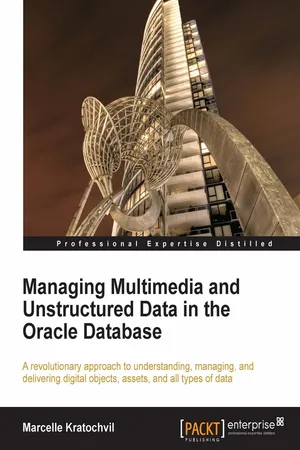![]()
Managing Multimedia and Unstructured Data in the Oracle Database
![]()
Table of Contents
Managing Multimedia and Unstructured Data in the Oracle Database
Credits
About the Author
Acknowledgement
About the Reviewers
www.PacktPub.com
Support files, eBooks, discount offers and more
Why Subscribe?
Free Access for Packt account holders
Instant Updates on New Packt Books
Preface
What this book covers
Who this book is for
Conventions
Chapter References
Reader feedback
Customer support
Errata
Piracy
Questions
1. What is Unstructured Data?
Digital data
Metadata
Defining unstructured data
Terminology
Image
Digital file
Digital image
Digital object
Digital content
Digital asset
Digital material
Digital library
Analyzing the digital object
Digital object types
Core types
Subtypes
Picture
Audio
Model
Creating new base types
Document
Video
Multimedia (Rich Media)
Data
Simulation
Genealogy
Virtual digital object
Digital object delivery
Manipulating digital objects
Conversion
Transformation
Extraction
Compression
Image comparison
Badly compressed
Thumbnail
Transposition
Searching
Product group
Location
Defining multimedia in the Oracle database
Photograph
Video
Audio
Document
Text
Artifact
Additional multimedia types
Composite types
Container
ZIP files
Metadata
The NULL case
Why store unstructured data in a database?
Manageability
Security
Backup/recovery
Integration
Extensibility
Flexibility
Features
Why not store the multimedia in the filesystem?
Why use Oracle multimedia and not a blob?
Addressing the concerns
Performance
Database size
Complexity
Summary
Exercises
Unstructured data conversion table
2. Understanding Digital Objects
Definitions
Raw format
Compression
Lossy data compression
Lossless data compression
Codec
Container
Understanding each image type
Photo
Icon
Color space
Color calibration
The RGB color model family
Viewing colors
Printing using the CMYK colorspace
Other color spaces
Little endian and big endian
Digital image storage formats
Raster graphics formats
Raw
Vector graphics
Audio
Bit rate
Encoding
Channels
Video
Frame
Frame resolution
Frame aspect ratio
Frame rate
Progressive scan versus interlaced
Codecs/containers
Issues when converting
Documents
Terminology
PDF
DOC/DOCX
ODT
TXT
Transformation
Digital object composition
The starting base – NULL object
The original image
Indexed digital object
Pyramid index
Derivatives
Masters
Components
Version hierarchies
Relationships
Unstructured data business cases
Sporting club
Charity
Neighborhood watch
News
Food
Government
Summary
Exercises
3. The Multimedia Warehouse
Comparing
The data warehouse
Data consistency
Logical Data Consistency
Dilapidated warehouse
Security
Performance
Information overload
Types of multimedia warehouses
Traditional
Image bank
Data mart
Public
eSales
Intelligence (security/defence)
Structures
Collections
Groups
Categories
Lightbox
Relationships
Thesaurus
Taxonomy
Metadata standards
Digital images
IPTC
EXIF
XMP
Audio
ID3
Relational
CDWA Lite
The Dublin Core® metadata Initiative
Darwin Core
Media Art Notation System
Image tagging
Crowdsourcing
Gaming techniques
Data types
Text
Date
Interval
Time
Season
Circa
Boolean
Number
Metric and imperial
Accession number
Name
Address
Filename
Spatial co-ordinate
Summary
Exercises
4. Searching the Multimedia Warehouse
Multilingual data
Storing
Diacritic
Multiple languages
Translating
Security
Searching
Indexing performance
Metadata based
Image structure
Electronic commerce
False positives
Stop words
The living search
Data mining
Big O notation
Representing the results
Interface
Visualize the results
Tag cloud
Infinite zoom
Complex social network
Tree map
Lightbox
VRML and SVG
Synchronized Multimedia Integration Language (SMIL)
HTML 5
Adobe Flash
Voice XML
Other devices
Braille devices
Audio
Search features
Summary groups
Workarea
Non discriminatory search
Result notification
Restrict the results
Control the output
Audit search
Designing a search language
Search context
Set theory primer
Order of precedence
Specialized query terms
Spelling mistakes
Sounds like
Stem search
Ranking
Mandatory and other terms
Word frequency
The trouble with documents
Autosuggest
Search engine scalability
Federated search
Fuzzy searching
Collaboration search
Summary
Exercises
5. Loading Techniques
Loading methods
Finding the images
Pull method
Vertical parallelism
Horizontal parallelism
Push method
Cartridge method
Loading method
Metadata matches to digital object
Digital object matches to metadata
Mixed digital object and metadata
Digital object no metadata
Many masters
Derivatives
Matching existing data to images
Filename encoding
Data cleansing
Loading decisions
Types of loading
Batch
Hot folder
Integration API
Manual
Loading step-by-step
Error handling
Logical errors
Loading via a workflow
Summary
Exercises
6. Delivery Techniques
Securing an image
Protection from theft
Is it really theft?
Modification
Disruption
Copying
Theft
Forgery
Destruction
Plagiarism
Illegal access
Replace
Accidental
Harvesting
Other
Protection methods
Visible
Preventive
Bookmarking
Reactive
Auditable
Self destruction
Accept
Legal proof
A look at different business situations
Copyright
Greeting card
Music
Electronic commerce
Not all browsers are the same
IP address country tracking
Order lifecycle
Payment methods
A comprehensive audit trail
Locking down the price
Post processing issue
What are you buying?
Price books
Pricing options
Understanding the business rules
Tax rule
Download rule
Pricing rule
User fees rule (pricing calculator)
Postage rule
Mixed orders
Split orders
Combining items
Free postage
Pick up
Negotiated
Delayed
Monitoring
Payment rule
Customer information rule
Customer trigger rule
Discount rule
Refund rule
Ticketing rule
Integrated stock management
Post-purchase workflow
Summary
Exercises
7. Techniques for Creating a Multimedia Database
Tier architecture
Traditional no tier
Two tier
Three tier
Virtualized architecture
Mobile applications architecture
Basic database configuration concepts
ASM—Automated Storage Management
Block size
UNIFORM extent size and AUTOALLOCATE
Locally managed tablespace UNIFORM extent size
Temporary tablespace
UNDO tablespace
SYSTEM tablespace
Redo logs
Analysis
Oracle Securefile architecture
Enabling storage in row
CHUNK
Logging
Cache
Managing duplicate images
Retention
Lob compression
Encryption
Read-only tablespace
Where does Oracle Multimedia fit in?
Understanding the ORDSYS data types
Creating a table
How to query?
Multimedia methods
Creating a schema
Oracle HTTP servers
Configuring the Oracle embedded gateway
Configuring Apache
Basic diagnostics
Windows
Unix
HTTPD.CONF file
Virtual hosts
Apache rewrites
External locations and security
Oracle directory
Granting access to a directory
UTL_FILE
UTL_TCP
Java
Discussing Raid, SSD, SANs, and NAS
Solid State Disk
Raid 0: stripe across both disks
Raid 1: mirror
Raid 0+1: stripe then mirror
Raid 1+0: mirrors then stripe
Raid 5: parity check
Raid 6: double parity check
NAS
SAN
Setting up Oracle XE to run Oracle Multimedia
Summary
Exercises...
